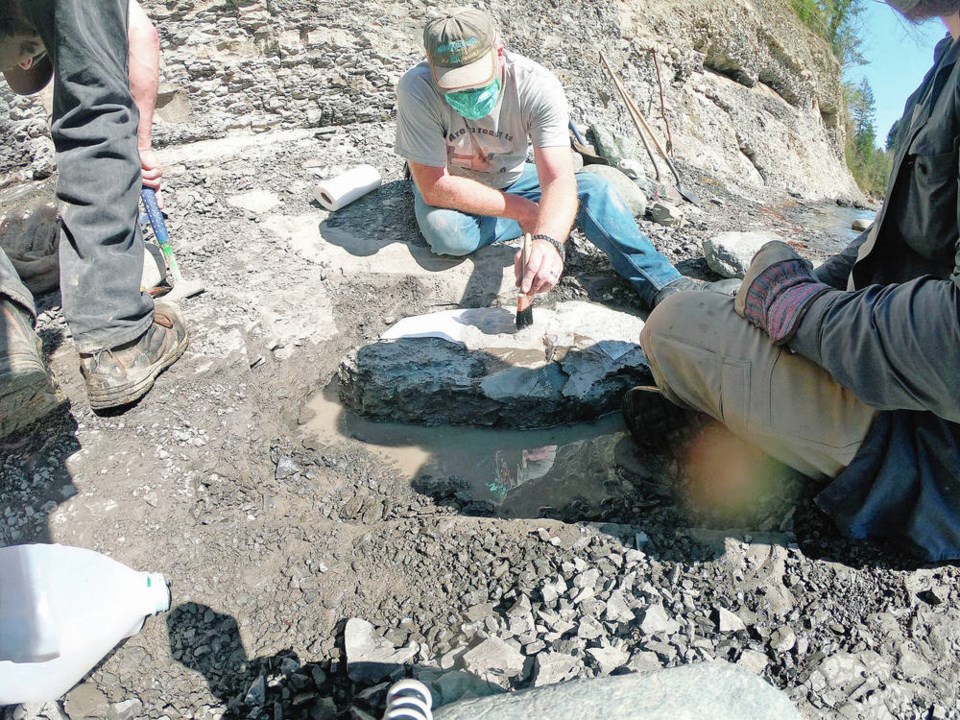Royal B.C. Museum staff will be meticulously cleaning off the remains of an ancient sea turtle discovered this year on the Puntledge River in hopes of figuring out if it is a new species.
The fossilized turtle is believed to have existed about 84 million years ago, based on the age of other fossils nearby.
It could be one of two known species from that area or something completely new.
“Either way, this discovery is a win for palaeontology in B.C.,” said Derek Larson, the museum’s palaeontology collections manager. “If the fossil is a known species, we’ll learn a lot of new information about that species because these specimens are rare and, so far, incomplete.
“If the fossil turns out to be a species that is new to science, that could exponentially advance our understanding of marine ecosystems millions of years ago.”
The fossil was discovered in January by Russell Ball of Courtenay on the Puntledge River in what is known as the Trent River formation. After spotting the fossil, Ball contacted the 91ԭ�� Island Palaeontological Society, which agreed it was likely a turtle.
He then contacted the Royal B.C. Museum, the provincial repository for significant fossil finds, and the B.C. fossil management office, which is responsible for protection and management of fossils in B.C.
“Russell Ball and the 91ԭ�� Island Palaeontological Society did everything right,” Larson said. “They recognized the discovery’s significant scientific value and immediately set to work ensuring the fossil would end up where everyone in B.C. will be able to access and study it.”
Professional palaeontologists and amateur fossil hunters know the Puntledge River often reveals fossils. But vertebrate fossils are more rare than invertebrate ones, Larson said.
He said the turtle fossil is not the only one in the museum’s collection, but it is the only one from the Trent River formation.
The fossil is encased in what is called mudstone or siltstone, and Larson estimates it weighs about 90 kilograms. A sled was used to haul it out of the area.
A pneumatic air scribe — a miniature air-powered jackhammer — will be used to chisel rock around the fossil, millimetre by millimetre.
How much of the turtle has been preserved is not yet known, Larson said.
What is known is that the turtle is disarticulated, meaning it does not have all its bones in a life-like position, he said, noting when such animals are buried, events can affect how much is preserved.
The oval-shaped fossil is about a metre long, which could have been the turtle’s size, or it might have been a little smaller when alive, Larson said.
He said there are multiple bones, with different parts of the shell preserved.
The oval shape is largely rock containing the fossils, he said, while the shell is in pieces.
The turtle lived in the ocean but it’s not closely related to modern sea turtles, Larson said.
B.C. Hydro helped with removal of the fossil, working with Larson to make sure the river’s water was at a low level so it would not be underwater when it was being removed from the site. B.C.’s Heritage Branch partnered with the museum on the project.
Larson said the discovery demonstrates the value of citizen science. “Without Ball and the other volunteers who helped out, we may not have found this specimen and certainly we would not have been able to extract the fossil so quickly.”
He encourages everyone to keep their eyes out for fossils, but cautions that beginner fossil hunters should review provincial fossil collection laws before setting out on their search.
To look at fossil collection rules go to: gov.bc.ca/gov/content/industry/natural-resource-use/fossil-management/collection-and-use.
